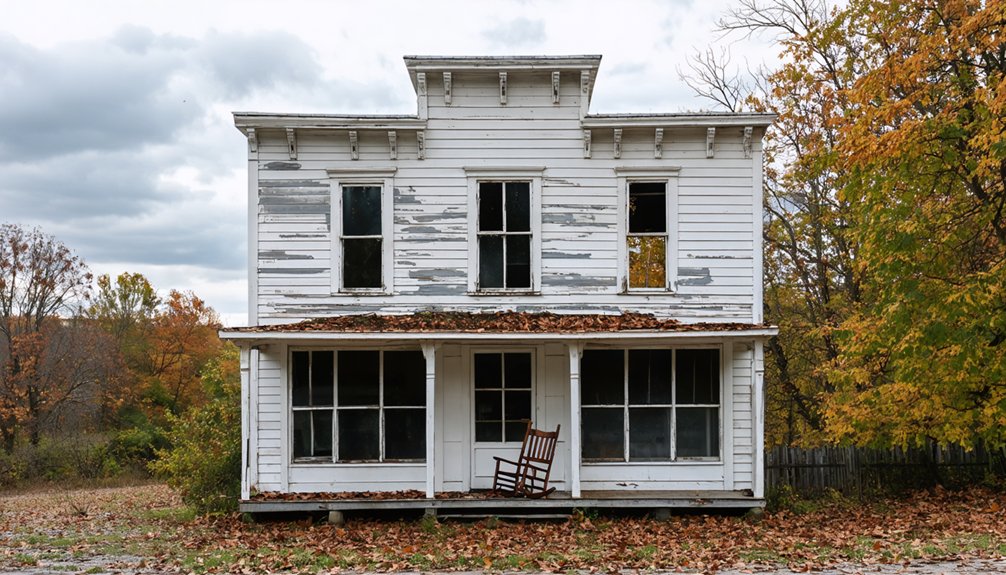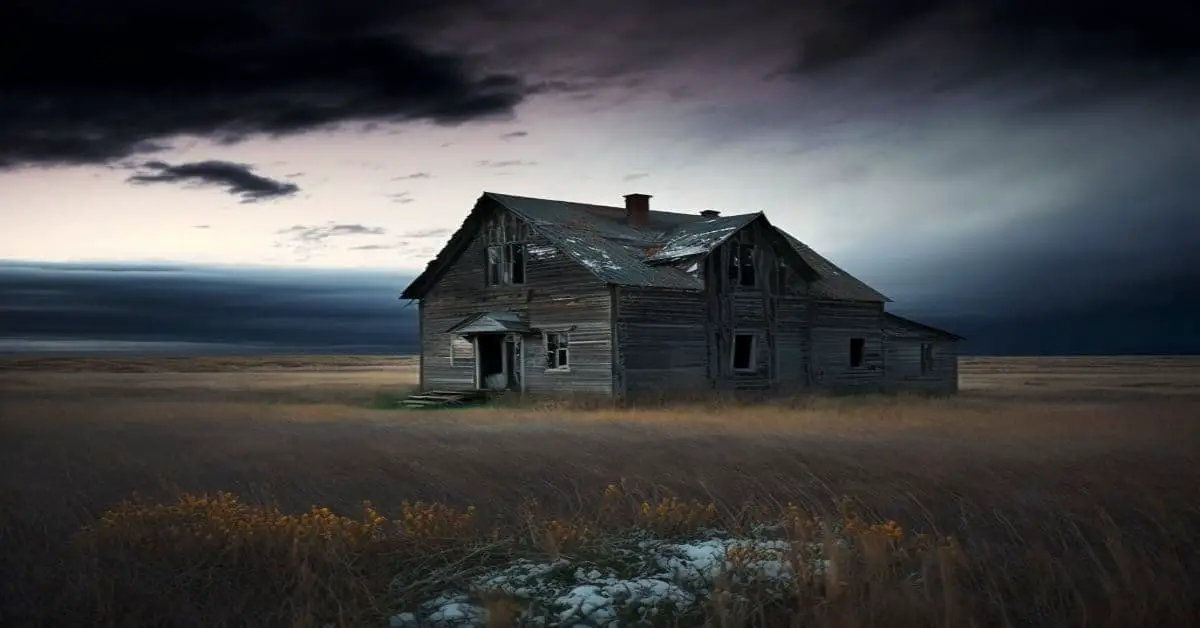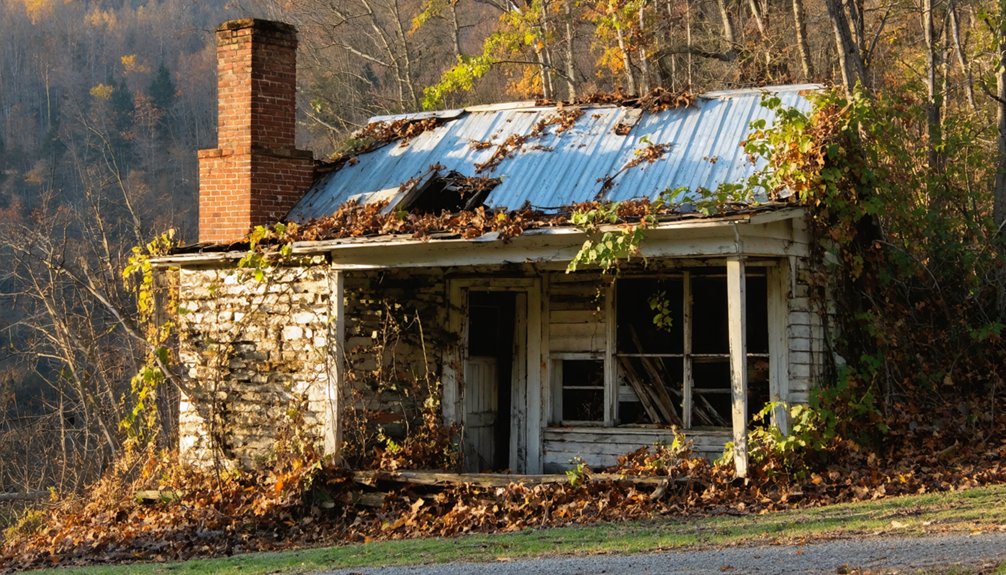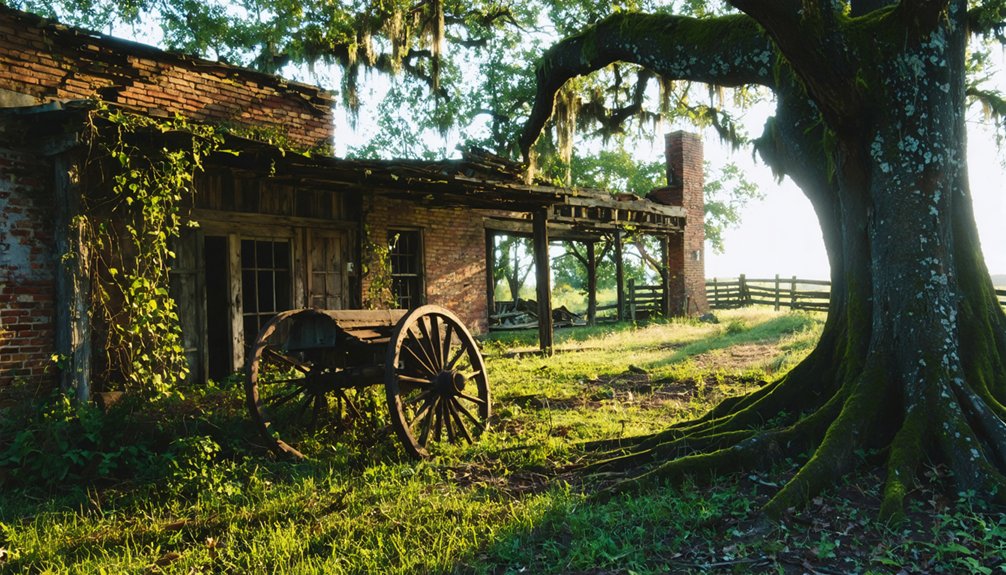You’ll find Bruno nestled in the Ozark Mountains of Marion County, Arkansas, where Hampton Creek‘s clear waters once sustained over 600 residents. Founded in 1885, this former settlement thrived under the McEntire family’s influence, boasting the region’s first vocational agricultural school and innovations in farming. Today, only the historic Baptist Church and cemetery remain as silent witnesses to Bruno’s past, while the surrounding forests and steep hills hold stories of this lost mountain community.
Key Takeaways
- Bruno was established in 1885 with 600 residents but experienced significant population decline by the 1950s due to economic shifts.
- The town’s prominence centered around Champion McEntire’s influence as postmaster and the family’s 236-acre landholdings supporting local development.
- Historic landmarks include the Baptist Church (1871) and cemetery, which remain as physical reminders of the former thriving community.
- The town hosted the first vocational agricultural school west of the Mississippi before school consolidation in 1974.
- Located along Hampton Creek in Marion County, Bruno’s geography features steep hills, dense forests, and clear streams in Ozark Mountain terrain.
A Lost Ozark Community
Though many ghost towns dot the landscape of the Ozarks, few tell a story as compelling as Bruno, Arkansas. You’ll find its origins in 1885, when it emerged as a promising settlement that would soon grow to over 600 residents.
The town’s cultural traditions flourished alongside its expanding population, with community gatherings and agricultural practices defining daily life. The weathered gravestones in the nearby cemetery reveal the deep history of Bruno’s earliest families. Like other rural areas, Bruno faced economic shifts and migration, leading to a stark population decline.
But like many American small towns, Bruno couldn’t withstand the dramatic economic shifts of the mid-20th century. By the 1950s, most residents had left in search of better opportunities elsewhere.
Today, you can explore what remains of this once-vibrant community: a post office still stands among scattered ruins, and nearby historic structures like the Eros general store offer glimpses into Bruno’s prosperous past, when it served as a hub of commerce and education in Marion County.
Natural Setting and Geography
Nestled in southern Marion County, Bruno occupies a distinctive valley along Hampton Creek, where crystal-clear waters flow northward through the rugged Ozark terrain.
You’ll find this ghost town about eight miles southwest of Yellville, surrounded by steep hills and dense forests characteristic of the Ozark Mountains.
Natural resources once thrived here, with mixed hardwood forests providing timber and shelter.
The area’s most striking water features include Hampton Creek’s numerous springs that emerge from its banks, creating a network of cold, clear streams.
The notable Ebbing Springs provided essential cold water for early residents’ food preservation and washing needs.
Majestic sycamores, elms, and willows line these waterways, their branches stretching over the crystal waters.
The creek, which eventually joins Crooked Creek downstream, supported abundant fish populations and shaped the community’s early development along Arkansas Route 235.
Much like the nearby city of Brno, Bruno developed around its natural waterways and mountainous terrain.
The McEntire Legacy
When you visit Bruno today, you’ll find the enduring marks of Champion Daniel McEntire and his wife Sarah, who established their 160-acre homestead in the mid-1840s as one of the area’s first pioneer families.
The McEntires transformed the local agricultural landscape through their farming practices and the introduction of essential services like their mill and cotton gin. Daniel McEntire was known as a skilled wagon maker who supported the community’s transportation needs. Together with Sarah, they raised eight children while building their legacy in Bruno.
Their influence continues through the Bruno Cemetery, originally the McEntire family burial ground, which they later donated to the community as a symbol of their civic commitment.
Early Settlement Foundations
Among the pioneering families who shaped Bruno’s early development, Champion McEntire and his wife Sarah Waters arrived from North Carolina in 1846, establishing their homestead along Hampton Creek.
Like many early pioneers, they capitalized on the area’s natural resources, choosing land rich with clear water and abundant springs. Champion quickly became a cornerstone of the community, serving multiple roles as farmer, postmaster, and wagonmaker.
Despite settlement challenges, the McEntires planted deep roots, raising at least seven children who’d further strengthen Bruno’s foundation. The McEntire family legacy continued well into the 1920s, as Archibald D. McEntire lived in Bruno until his death in 1926. Their 160-acre property, which included facilities like a mill and cotton gin, formed part of the town site itself. The land eventually grew to 236 total acres through their continued expansion.
Through their entrepreneurial spirit and civic engagement, the McEntires helped transform Bruno from wilderness into a thriving settlement.
Family’s Agricultural Innovations
The McEntire family revolutionized Bruno’s agricultural landscape through three major innovations during the late 1800s.
You’ll find their legacy in the precision farming techniques they developed, starting with their innovative crop rotation system that maximized soil fertility across their extensive landholdings. They introduced early mechanization by bringing the area’s first steam-powered thresher, which transformed how local family farming operations harvested their grain. Their techniques would later align with the Division of Agriculture’s commitment to data-driven research for practical farming solutions. Like modern Farm Family of the Year winners, they set high standards for agricultural excellence.
Most significantly, the McEntires pioneered sustainable practices through their experimental agroforestry program, integrating timber management with traditional crops.
Their demonstration farm became a hub for community education, where they taught neighboring farmers these innovative practices. Through workshops and hands-on training, they helped establish Bruno as a regional leader in agricultural advancement, setting standards that influenced farming methods throughout northern Arkansas.
Lasting Community Impact
Beyond their agricultural innovations, McEntire family influence shaped Bruno’s development in lasting ways you can still trace today.
When Champion McEntire settled here in the 1840s, he established more than just a homestead – he helped forge community resilience through his roles as postmaster and wagonmaker.
You’ll find their legacy woven into Bruno’s historical narratives, from the 236-acre landholdings that supported local growth to the Bruno Cemetery, originally known as McEntire Cemetery.
The family’s business ventures, including William C. McEntire’s mill and cotton gin, created essential employment opportunities that sustained the region’s economy.
Through marriages with local families and their dedication to public service, the McEntires’ impact on Bruno’s social fabric extends well beyond their initial settlement years.
Pioneer Days and Peak Years

Situated along Hampton Creek in southern Marion County, Bruno emerged as a rural settlement during the late nineteenth century, drawing pioneers to its abundant natural resources. You’d have found early settlers facing pioneer challenges as they carved out homesteads among the sycamore, elm, and willow trees. The cold, clear waters provided fish, while natural springs supported their agricultural practices.
During its peak in the early 1900s, Bruno thrived as a close-knit farming community. You would’ve seen families working together, sharing labor and resources as they tended their crops and livestock.
While the town never grew large or industrialized, it supported the basic needs of its residents with a general store, church, and likely a small school, embodying the self-sufficient spirit of rural Arkansas settlements.
Educational Heritage and Innovation
As Bruno’s pioneer community took root, its dedication to education set it apart from other rural settlements in Arkansas.
You’ll find the town’s most remarkable achievement in establishing the first vocational agricultural school west of the Mississippi River, sparking an educational transformation across the region.
The school’s innovative approach combined traditional academics with hands-on vocational training, while its Plain Traditional architecture stood as a symbol to rural education’s importance.
Students learned modern farming techniques alongside core subjects, and the school fostered community spirit through FFA activities and social gatherings.
Mr. Edward’s leadership inspired widespread support for these educational initiatives.
Even after the school’s consolidation in 1974, the building’s legacy lives on through its recognition in historic registers, reminding us of Bruno’s pioneering role in rural education.
The Decline of Rural Life
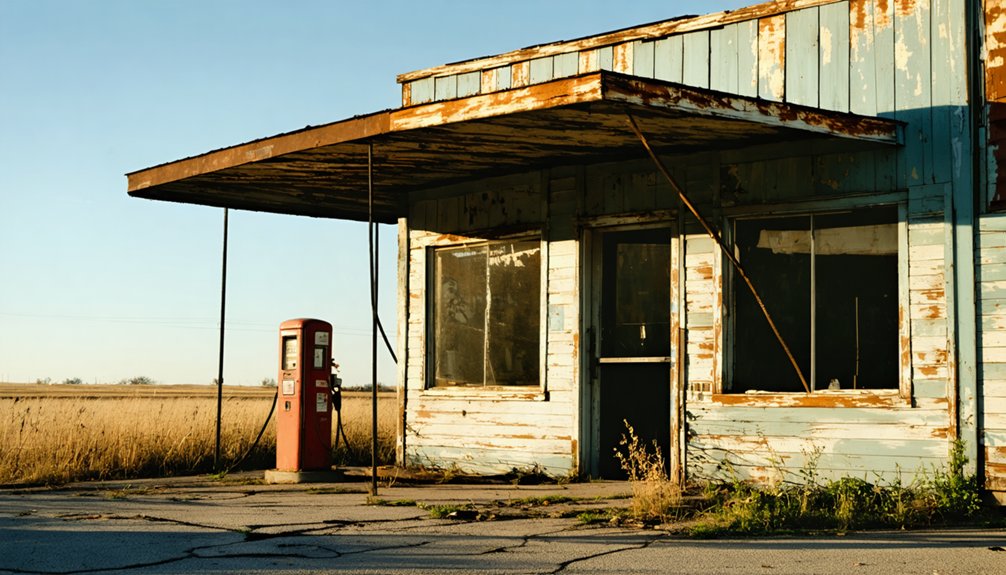
While Bruno’s educational legacy flourished in earlier decades, the late 20th century brought significant challenges to this rural community.
You’ll find Bruno’s story mirrors the rural depopulation trends seen across Arkansas, where rural regions have experienced a 5% population decline while urban areas have grown by 30%.
The agricultural decline impacts hit particularly hard, as farmers faced mounting pressures from low commodity prices and rising input costs. Even record yields in 2024 couldn’t save many family farms from financial strain.
You’ll notice how Bruno’s aging population, limited job opportunities, and the exodus of younger residents to urban areas have transformed this once-vibrant community.
The town’s struggle reflects a broader pattern of rural challenges, where declining land values and limited economic diversification have reshaped the landscape.
Surviving Landmarks Today
When you visit Bruno today, you’ll find two key landmarks that have withstood the passage of time.
The Baptist Church, while weathered by decades of abandonment, maintains its original structural form at the heart of the former community.
You can also explore the historic cemetery, which stands as a memorial to Bruno’s past inhabitants and provides a glimpse into the town’s social fabric.
Baptist Church Standing Strong
Though historical records confirm the Baptist church’s establishment in Bruno during 1871 as the first of its kind in Marion County, the current status of this pioneering religious landmark remains uncertain.
The church’s rich history as a cornerstone of community gatherings in Bruno’s early days has left an indelible mark on the region’s spiritual heritage.
During Bruno’s prime, the Baptist church served three crucial functions:
- Primary place of worship for the area’s earliest Baptist congregation
- Central hub for social activities and community meetings
- Spiritual anchor point during the town’s most active period
While Bruno has since transformed into a ghost town, the church’s legacy endures as a symbol of the area’s religious foundations, though its physical condition remains undocumented in contemporary records.
Last Historic Cemetery Remains
A solitary cemetery stands as Bruno’s most prominent surviving landmark, marking the final resting place of the town’s earliest residents.
You’ll find this historic site tucked away in Marion County’s remote landscape, where it tells the silent story of Bruno’s transformation from a bustling community to a ghost town.
While ghost town legends swirl through the Ten Mile Creek Bottoms nearby, the cemetery itself remains a dignified representation of the area’s past.
Unlike neighboring ghost towns like Eros, which still maintains several historic structures, Bruno’s cemetery preservation needs have gone largely unaddressed.
You can still visit this piece of Arkansas history, though you’ll want to connect with local guides for the best access.
It’s one of the few remaining connections to Bruno’s 1970s decline.
Historical Significance
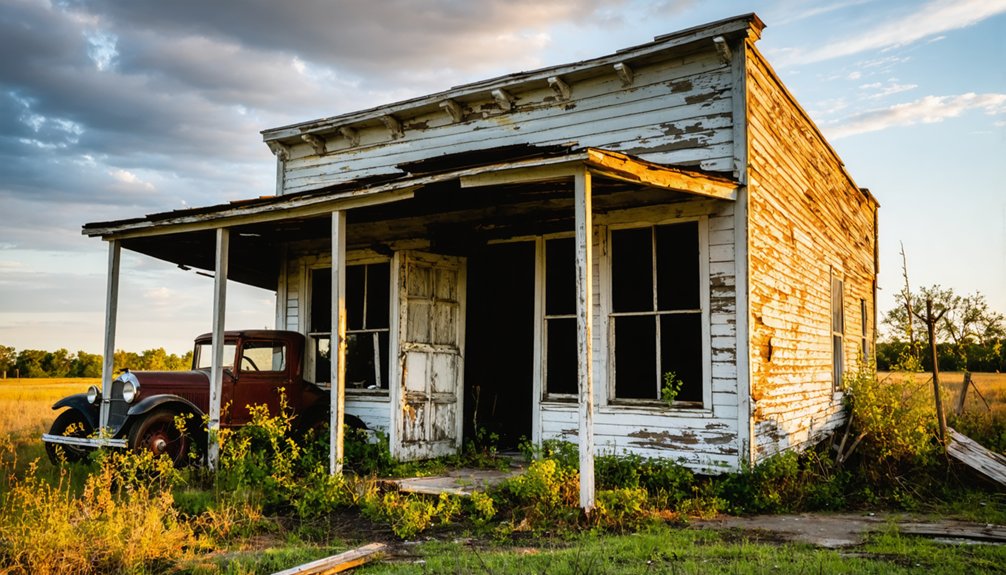
Located in southern Marion County near Hampton Creek, Bruno emerged as a thriving settlement during the 1800s, growing from its Native American roots into a bustling community of over 600 residents.
The town’s historical narratives and cultural heritage paint a picture of a vibrant community that shaped the region’s development.
Bruno’s significance is highlighted by these key elements:
- Educational impact through its school district, which fostered community growth until the 1970s
- Agricultural prominence demonstrated by active FFA participation and community banquets held on local farms
- Natural resource utilization, with Hampton Creek’s clear waters supporting both wildlife and agricultural endeavors
Today, while only the church and cemetery remain as physical reminders, Bruno’s legacy lives on through preserved stories and historical records of life in the Ozarks.
Visiting the Ghost Town
While Bruno’s historical legacy draws curious visitors, reaching this remote ghost town requires careful planning and preparation.
You’ll need to navigate Highway 65 to Junction 235, then follow the left fork along Ten Mile Creek Bottoms, where local tales of ghostly encounters add mystique to your journey.
Bring essential supplies, as you won’t find modern amenities in Bruno.
The post office and cemetery serve as your main landmarks, offering rich photographic opportunities among weathered gravestones and abandoned structures.
You can explore the surrounding area on foot, discovering remnants of 19th-century homes and the former school district.
Consider extending your adventure to nearby attractions like the Rush Historic District or Hurricane River Cave, but remember to pack water, food, and navigation tools for this off-the-grid experience.
Frequently Asked Questions
Are There Any Reported Ghost Sightings or Paranormal Activity in Bruno?
You’d expect spine-tingling ghost stories from this desolate town, but there aren’t any documented paranormal investigations or ghost sightings in Bruno. The eerie silence speaks louder than any specters could.
What Happened to the Mcentire Family After Bruno’s Decline?
You’ll find McEntire descendants scattered westward, with some moving to Texas and California, while others maintained their family legacy in Marion County through farming and business ventures until the 1900s.
Can Metal Detecting or Artifact Collecting Be Done in Bruno?
You’ll need landowner permission and must follow strict metal detecting rules. While the area’s packed with history, artifact preservation laws protect many sites, so check regulations before exploring Bruno’s treasures.
Is Permission Required From Any Authorities to Visit Bruno?
Yes, you’ll need to follow visiting protocols and local regulations. Since most land is likely private property, you should contact Marion County officials or property owners before exploring the area.
Are There Any Annual Events or Reunions Held by Former Residents?
Like a forgotten chapter in time’s book, you won’t find regular community gatherings or historical reunions in Bruno. While locals may share stories informally, there aren’t any documented annual events for former residents.
References
- https://podcasts.apple.com/gb/podcast/episode-66-the-ghost-town-of-bruno-arkansas/id1722644187?i=1000680548996
- https://www.youtube.com/watch?v=sJ1V8Yjr04w
- https://arkansasfrontier.com/ghost-towns-in-arkansas/303766/
- https://www.argenweb.net/marion/history/history-marion-co-ar-22-bruno.html
- https://www.youtube.com/watch?v=3oZuUMZk_Eo
- https://en.wikipedia.org/wiki/List_of_ghost_towns_in_Arkansas
- https://www.argenweb.net/marion/history/history-marion-co-ar-26-bruno-school.html
- https://kkyr.com/arkansas-top-5-ghost-towns/
- https://www.wikiwand.com/en/articles/Bruno
- https://www.youtube.com/watch?v=Vy8ORzJzQjM
